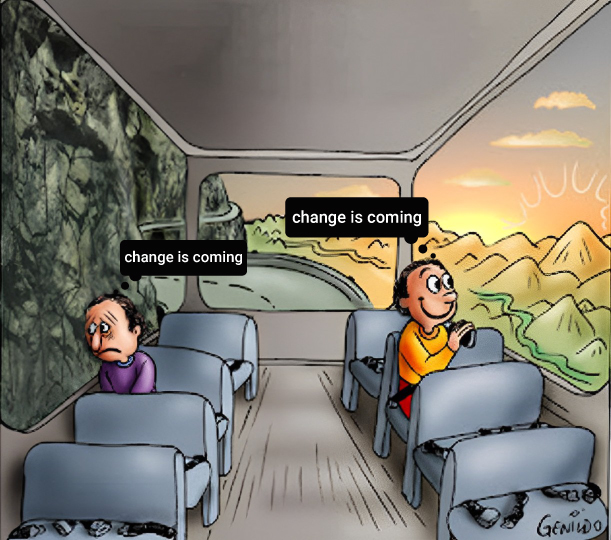How to lead through big change without sacrificing results
As a leader (nay, simply as a person in the world), you know that change is inevitable. And hard.

In an organizational context, change can manifest in a lot of different ways:
- Layoffs or reduced headcount
- New “time saving” technologies
- A shift in strategy to deliver more value to customers
- Updated ways of collaborating with colleagues
- Transitions in leadership
- Mergers and acquisitions
You probably also intuitively know that you can change by disaster or change by design. You can either be ready to move through changes like a surfer navigating waves, or in the face of the waves you can simply hold your breath and prepare for impact.
Which version do you prefer?
If you picked the surfer version… welcome, fellow leader! You are going to be uniquely primed to tackle the bumpy, uncharted seas of this modern world of work. And although it’s going to be a tough path, we’ve seen what great leaders do to drive positive transformation without sacrificing results or performance.

Use good judgment
This sounds like table stakes, but hear us out. For a lot of the change challenges leaders are facing today, there are no “best practices.” You won’t find the answer in the company handbook or through a quick Quora search. That’s where your judgment as a leader comes in. The best leaders are the ones who seek alternative viewpoints and can leverage relevant data, diverse perspectives, and peer advice to make sound decisions.
Effectively communicate
Again, table stakes but let’s add some color to what we mean. The first requirement to effective communication is that you understand the problem statement enough to share it with someone else. You have to be able to connect the rationale to your strategic goals. Can you explain your rationale to a fourth-grader? If not, we’ve got a problem! Communicating something clearly to a lot of people requires deep enough knowledge of the issue that you can boil it down and repeat the message over and over again. Even if people take issue with the change, nobody should be wondering “hey why are we doing this anyway?”
To communicate effectively, before a big change you need to make sure you can answer these questions inside and out:
- Where do we want to be?
- How does the change best serve our users, customers, or clients?
- How does the change benefit our team?
- What business outcomes are we hoping to achieve?
Invite participation
Gathering buy-in is a huge part of making any change successful. Figure out which decisions you want to include people in, and then check out our guide to team decision making to effectively fold more stakeholders into decisions that will impact them. This is not only energizing and good for morale, but it will also help the changes stick.
Encourage innovation
This sounds so bland and we wish for a more interesting way to put it, but an innovation mindset really is crucial for success in today’s operating environment. Here are some concrete ways to take innovation from a buzzword to something more tangible:
- Build a diverse team to generate more ideas and uncover blind spots
- Hold space for creativity (yes, and…) by fostering a psychologically safe environment(allow for anonymity, give people heads down time to think/ideate, step back to allow your team to surface issues)
- Block time and space for innovation
- Ensure people have access to the right people / information to make sound decisions
- Challenge assumptions by asking questions that spur lateral thinking
- What if we had to do this 10x more cheaply?
- What if we had to solve this problem tomorrow?
- What is the conventional approach, and what if we can’t do it that way?
- Reward behaviors that you want to see (i.e. big swings, failure, risk taking)
Clear barriers to help your team keep things running smoothly
Engage your team in frequent check-ins to ensure that people have the support and tools they need to drive results and maintain performance. Here are the following supports you’ll need to furnish your team with:
- Resources
- Time
- Permission
- Autonomy
These are what your people need to drive change while ALSO ensuring that the trains are still running on time and that no existing balls are dropped.
Practice self-reflection
What is your own relationship to change? Some people may crave and embrace change with open arms. Others may fear a loss of security, position, relationships, or even something core to their professional identity. Grief and loss are a natural part of the change process. Maintaining self-awareness about your own behavioral patterns in response to big transitions is an essential tenet of effective leadership. Get honest and vulnerable to the extent that it’s comfortable for you. Reflect on your own mental blocks and assumptions so that you can confidently and compassionately lead others through rocky and uncharted waters.
 Ready to Talk Now?
Ready to Talk Now?